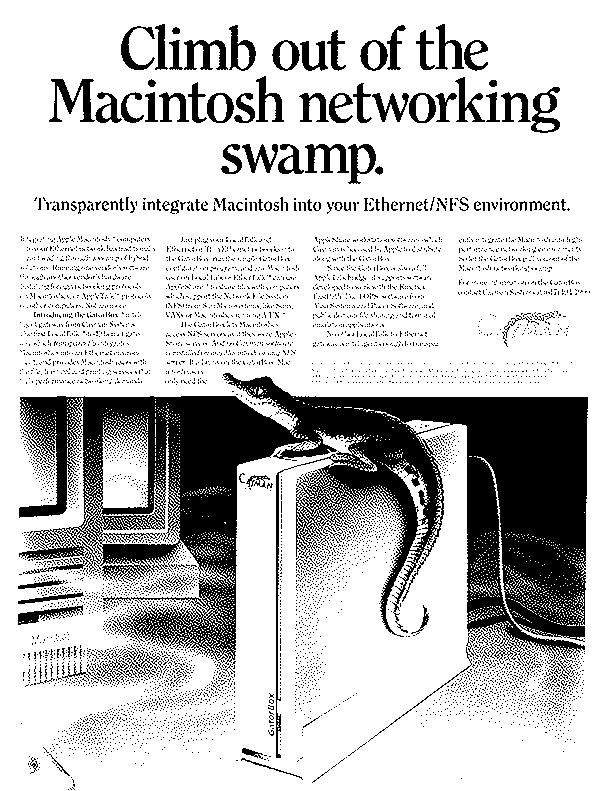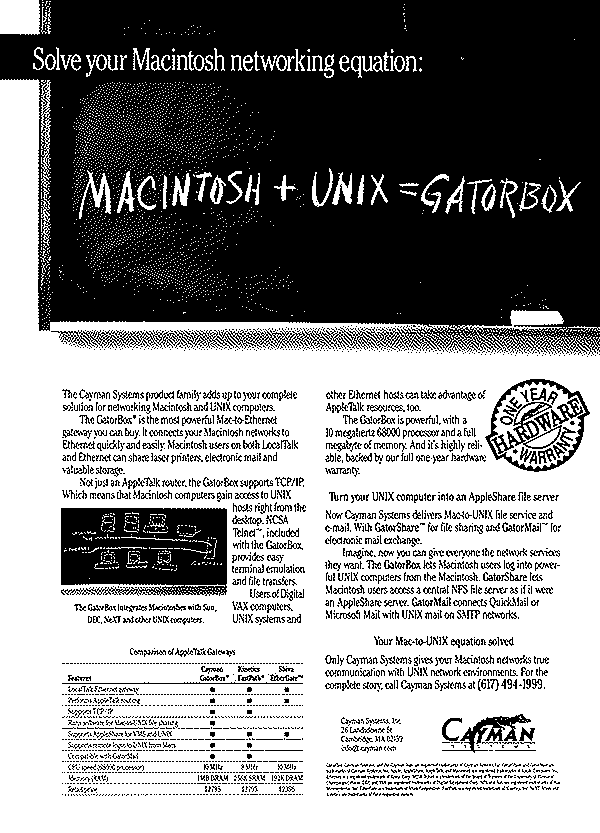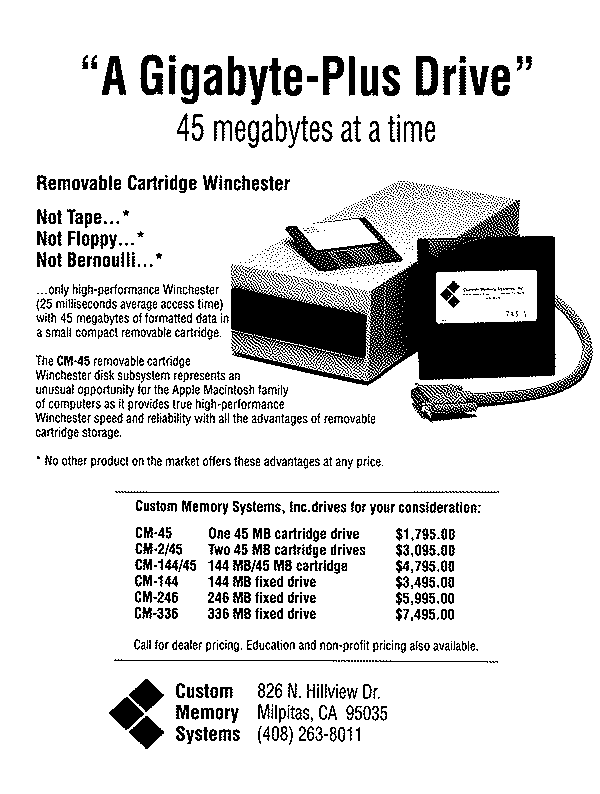Cayman GatorBox
2,300 words
23K on disk
January 1988
 Cayman GatorBox
Cayman GatorBox
“Nothing else currently does this”
This is a story of a very unique networking product, the Cayman GatorBox. A flawed device, to be sure — but also a compelling synthesis of many different file sharing protocols and communication languages, integrated into one small metal box. For just a few thousand 1980’s dollars, Cayman promised to link together Unix workstations on DARPA-class Ethernet with Macintosh computers connected by Apple’s small-scale, friendly AppleTalk cables.
An intelligent gateway
Our journey starts in January 1988. at the Infonetics Desktop Communications Conference. It was at this Anaheim event that Cayman Systems Inc. of Cambridge, Mass. announced GatorBox, an “intelligent LocalTalk-to-Ethemet gateway” that “lets Mac users operate AppleTalk applications on Ethernet”, in the words of company President Ted Stabler. The GatorBox was due to ship in April 1988, at a price “competitive” with other products.
By March, MacWEEK hand nailed down that price: $2,295. The May issue of Macworld was written before that price was publicized, but did contain details about the “network interfaces for LocalTalk network and Ethernet or ThinEthernet”. The first of these was what we call Thick Ethernet today, expressed as a 15-pin AUI connector, while the second was the coaxial cable for 10Base2. Let’s take a look at those interfaces:

Two months later, Cayman was recruiting for software engineers
in the back pages of MacWEEK:

… and inside, promoting the new device in a full-page ad:

The full-court press might have been premature. By July, MacWEEK hit the presses with both a delayed August shipping date for the GatorBox and a much higher price, $3,495. But the value proposition for the GatorBox was always a unique blend of hardware and software features. Unlike the simpler and cheaper FastPath from Shiva, Cayman’s product bridged not only physical layers and protocol stacks but user-facing, “Level 7” application protocols such as AFP and NFS. That was enough provide “stiff competition” to competing devices such as the Kinetics FastPath 4, despite the $1,000 price premium, in the view of MacWEEK.
The GatorBox from Cayman Systems of Cambridge, Mass., provides a bridge between AFP and NFS systems, allowing the two architectures to connect while retaining transparent file access for all users. Using this approach, a Mac user can access Sun files and vice versa. Apple has traditionally looked to third-part vendors to round out its product offerings, and Cayman has been only too happy to oblige.
Handling these protocols directly at the firmware level could mean much simpler client configuration — rather than install an NFS client on the Mac, and compile CAP for Unix machines, the machines retained their native software experience and all translation took place on the GatorBox. In the words of MacUser, “[GatorBox] transparently connects LocalTalk to Ethernet – no software needs to be installed on any machine.” GatorBox soon found customers in higher education, where mixed networks of Macs and Unix machines were common:
At Harvard University, Cayman’s GatorBoxes are being used by 100 students in the Graduate School of Design for information sharing among Macintoshes and Sun workstations. “The NFS functionality of GatorBox has allowed students to download their homework on either Macs or Suns,” said David Kovar, who is a technical consultant for Harvard’s Office of Information Technology. “That’s especially important here since we already have a lot of Suns and just started using the Macintosh last fall.”
Even the presidents of other networking companies were impressed. Writing in the May 1990 issue of MacUser, Farallon head honcho Reese Jones noted:
While Apple and Sun duke it out over protocols, with the use of a Gator Box from Cayman Systems, you can convert AFP to NFS, and LocalTalk to TCP/IP Ethernet. AFP clients on the AppleTalk side can “see” an NFS server as an AFP server, gaining transparency between machine types, alternate file systems, and network operating systems.
Little wonder that president Stabler called his product “the first intelligent gateway from the Mac to Ethernet” — and capital markets agreed. Cayman raised US$1.8M from venture capital firm Concord Partners in early 1989.
And new markets for Unix-to-Mac connectivity were emerging every day: what MacWEEK described as the “the unveiling of the first Mac-to-NeXT connectivity product” took place at Macworld Expo in San Francisco that month. Stabler’s claim that GatorBox had shipped in conjunction with NeXT’s launch in late 1988 suggests that either the GatorBox had slipped from its promised August shipping date — or that a software revision optimized for NeXT’s implementation of NFS had been released in that same time. Regardless, Cayman “…have the opportunity to be at the forefront of an emerging computing frontier… this is as exciting as the Mac’s development five years ago.” Indeed, integrating NeXT and Mac systems wouldn’t get easier until the release of NeXT’s AppleTalk stack in NeXTStep 3 in late 1992, leaving a substantial window for Cayman to sell into workplaces with both of Jobs’ creations.
1989 also brought changes to the fundamental protocol the GatorBox dealt with: AppleTalk 2.0 promised to break free of the node-number and architectural limits that hindered complex integrations. But in addition, it promised software routing between different network interfaces in the same Mac. A Macintosh II with an Ethernet NuBus card could theoretically perform some of the same tasks as the GatorBox itself. “Before, I had to rely on hardware from Kinetics and Cayman”, said one beta tester. With the complete GatorBox setup still retailing for $3,500, probably more than one customer started considering such an option. But Cayman needn’t have worried — others “do not believe that software bridges can provide the functionality or performance of hardware-based solutions.”
Cayman’s response was ready by June of that year: they would “introduce two new products and restructure another in support of AppleTalk Phase 2.” The modular hardware architecture shown in the photo above allowed the release of the $3,500 GatorBox T, with Token Ring taking the place of the Ethernet module. And $700 GatorCard — actually a rebrand of the Racal Interlan — would add Ethernet to the Macintosh II and SE, offering a single-vendor solution for workplaces introducing higher speeds to their Macintosh networks.
But it was the GatorBox itself that saw the most changes in response to AppleTalk Phase 2 — at least in terms of bundling and marketing. While a short-term maintenance update (at a “nominal charge” ) would upgrade the GatorBox’s AppleTalk routing to Phase II compliance, an “extensive restructuring” of the product would see the higher-level protocol translations broken up into optional modules, or “GatorBox applications”. Each module could be downloaded onto a base GatorBox, adding functionality at the same time it added revenue to Cayman’s bottom line.
The new lineup looked like this:
GatorBox: $2,795, AppleTalk-TCP/IP routing only
GatorShare: $1,995, AFP/NFS, third quarter of 1989
GatorPrint: $595, PAP/LPR, fourth quarter of 1989
GatorMail: $995 for 10 Mac users, SMTP/Microsoft Mail 2.0, February 1990
The cost savings were clear — although so was the eye-watering cost of nearly $5,000 to achieve the functionality previously offered for $3,500. The press generally repeated Cayman’s company line:
Though previously sold as one product, Cayman unbundled the two products to appeal both to users who need basic LocalTalk-to-Ethernet routing and to those who need the full functionality of an NFS (Network File System) gateway.
In the new, “unbundled” world, software add-ons could be announced (and priced) as quickly as Cayman wanted market attention (or additional revenue.) Yet the actual software itself often seemed to lag. If journalists noted that GatorMail was “originally announced in July 1988 and now due sometime in early 1990” , Cayman pushed ahead with GatorMail-M, which was licensed from StarNine and offered support for DOS MS Mail clients in addition to Macs. (Although scribes noted Cayman “has not yet set pricing or a release date for GatorMail-M.”) . Next to be announced was GatorMail-Q, a “QuickMail-to-Unix mail gateway based on StarNine Technologies’ Mail*Link [SMTP] software”. . The two StarNine-licensed products ran on the mail servers, no special firmware needed to be loaded onto the GatorBox itself. They finally reached users in February 1990.
GatorMail is transparent to users, according to Cayman. Incoming messages from Unix machines appear under the QuickMail or Microsoft Mail interface. For outgoing mail, long Unix addresses can be hidden by aliasing, so that only the name or nickname of the Unix recipient appears in the directory.
As 1990 dawned, Cayman seemed to be cresting a wave. The GatorBox was demonstrated at trade shows such as Uniforum and at Apple’s own AppleTalk roadshow seminars . Splashy full-page ads caught readers’ eyes in MacUser and Macworld:

…while MacUser devoted an entire four-page article to the GatorBox . If Vernon Keenan’s Sharing: From Apples to Alligators was critical of Cayman’s documentation, it also suggested that the need to bridge Mac & Unix network protocols was mainstream enough to merit coverage in a consumer magazine.
It’s Keenan’s article, in fact, which raised the first contemporaneous criticism I’ve seen of a weakness in the GatorBox product: the need to load the operating system and configuration at every power-on. This limitation was particularly acute in Cayman’s 1.4.1 software release, which required a LocalTalk-only Mac, or a Unix TFTP server, to start up:
The GatorBox’s essential software. GatorKeeper, is stored in a folder on the administrator Mac and is automatically downloaded when the GatorBox is rebooted; the Mac must be turned on, connected to the GatorBox’s LocalTalk network, and have GatorKeeper running to reboot successfully. A UNIX host can also act as a boot server for the GatorBox. This booting scheme is unfortunate, because it relies on the boot server’s being available at all times. It would be better to have the software download to the GatorBox once and remain there, battery-backed, until the next software upgrade. Shiva’s EtherGate is an excellent example of this type of approach.
There’s no better way to describe this flaw than the pointed critique that Keenan offered way back in 1990. indeed, for retro collectors, the original GatorBox’s dependency on an external server to boot nearly rendered all the devices premature e-waste, until the software was located, archived, and shared.
One of the most useful parts of this MacUser test is the real-world performance numbers — and these numbers belie the idea that a powerful UNIX system would translate into a fast AppleShare file server:
Copying a 2-megabyte file from an AppleShare server on EtherTalk to a Mac client on EtherTalk takes 31.5 seconds. It takes 61.5 seconds to copy the same file from the NeXT NFS server to the EtherTalk Macintosh client. The additional overhead comes from the GatorShare gateway.
This stands in contrast the promise that “With the GatorBox, Macintosh users can turn the [NeXT] cube into a high-performance AppleShare server, according to Cayman officials.” Yet the results weren’t consistent across all interfaces — bizarrely, LocalTalk-only Macs enjoyed a speedup that Ethernet-equipped workstations did not:
“When a Mac on LocalTalk communicates with an NFS server on Ethernet, the story changes… GatorShare’s gateway (not GatorBox’s router runction, as one might expect) is used… Seemingly counterintuitive, routing between LocalTalk and EtherTalk with the GatorBox is slower than GatorShare’s translation of LocalTalk AFP to Ethernet NFS.”
Another criticism Keenan had was the ersatz Finder-esque interface that GatorKeeper used to manage devices. “GatorKeeper’s interface, although iconic, is not very intuitive. It’s also nonstandard; the Trash appears in the window instead of on the desktop.” This is a common critique of those Macintosh interfaces which are inspired by the Finder, going so far as to replicate the design language and logic of an interface that the programmers no doubt assumed the user would be familiar with already. But problems are likely to arise when software looks like something expected — and then behaves differently. HyperCard is the best-known example of this — a world unto itself, despite the shared programmers and designers (Atkinson, Kare) with the Macintosh’s own operating system. I’ll reserve judgement until I get my own GatorBox working, as I’ll need to use this software myself.
Yet for all these flaws, the essential promise of the GatorBox shone through: users could finally link their the Sun or NeXT workstations on Ethernet with the Macintosh computers that were increasingly being used for desktop publishing and other graphical tasks:
Nothing else currently does this, so if you want to get at NFS servers through the familiar AppleShare software interface, GatorShare is the product to buy.
Another comprehensive review landed in the June 1990 issue of MacUser.
Towards the 1.5 release
Some of the problems Keenan encountered would be fixed by a new 1.5 software release, which included features such as SNMP, tunneling AppleTalk through TCP/IP networks without EtherTalk, and security options such as hiding devices from users in other AppleTalk Zones. The release also supported protocols such as RIP, MacIP and atalkad, which “let administrators route, configure and monitor AppleTalk packets on TCP/IP networks more efficiently.”
GatorShare was also revised to version 1.5, which supported Apple’s DOS AppleShare client (bundled with their ISA LocalTalk cards), and “byte-range locking, which permits the use of multi-user databases across the GatorBox gateway” . (Keenan acknowledged this feature was coming soon during his MacUser evaluation.) Re-mapping of Macintosh characters into NFS-compliant strings was another improvement. And a small INIT could do the job of loading the initial software onto the GatorBox, supplementing the previous requirement to have a copy of the GatorKeeper application running on a Mac.


